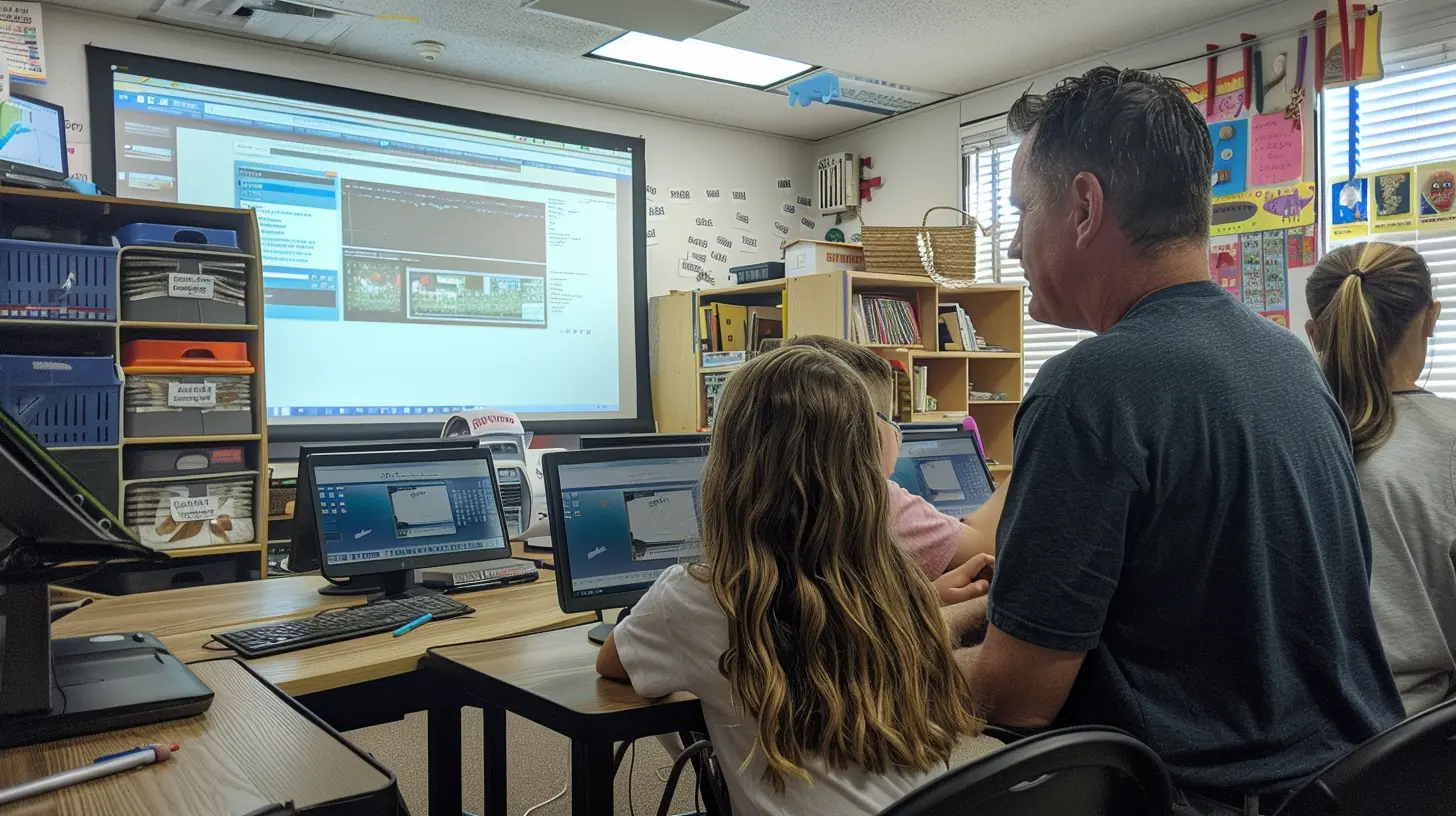13 March 2025
In today’s fast-paced digital world, education is constantly evolving. Traditional classroom methods are being complemented (or even replaced) by innovative digital tools. One area of education that has seen a significant transformation is assessment – and more specifically, formative assessment. If you’re wondering how you can keep students engaged while assessing their learning journey, the answer might just lie in digital formative assessment tools.
But, what exactly are these tools? And how can they help you keep students motivated and on track? Stick around, because that’s exactly what we're diving into!

What Are Digital Formative Assessment Tools?
Let’s start with the basics. Formative assessments are ongoing checks for understanding that happen during the learning process. Unlike summative assessments (think final exams or end-of-term projects), formative assessments are low-stakes and are meant to give both the teacher and the student insights into the student’s progress.Now, when we throw the word "digital" into the mix, we’re talking about using online platforms, apps, and software to carry out these assessments. These tools help to collect real-time data on student learning, making it easier for teachers to adjust their instruction and for students to self-reflect on their progress.
So, why go digital with formative assessments? The short answer: they’re engaging, interactive, and often more efficient. Plus, they offer a variety of formats – from quizzes and polls to interactive games and collaborative activities.
Let’s explore how these tools can truly engage students and enhance their learning experience.

Why Digital Formative Assessment Tools Are a Game-Changer
1. Instant Feedback
One of the most significant advantages of digital tools is the ability to provide instant feedback. Gone are the days when students had to wait for days (or sometimes weeks!) to receive feedback on their work. With digital formative assessments, students can know right away where they stand.Imagine being able to correct mistakes and adjust your learning in real-time. That’s exactly what students experience with tools like Google Forms or Kahoot!. Instant feedback helps students identify gaps in their understanding and encourages them to take immediate action.
Example: If a student answers a question incorrectly on an online quiz, they might get an immediate explanation of why their answer was wrong, and even a suggestion for additional resources to help them understand the concept better.
2. Increased Engagement Through Gamification
Who says learning can’t be fun? Many digital formative assessment tools incorporate gamification elements, turning what might otherwise be a boring quiz into an exciting, competitive experience. Tools like Kahoot!, Quizizz, and Classcraft allow teachers to create games and challenges that students can participate in, either individually or as teams.What’s great about gamification is that it taps into students' natural love for competition and rewards. Whether it’s earning points, badges, or climbing a leaderboard, these small elements can make a big difference in student motivation. When students see learning as a game, they’re more likely to stay engaged and put in the effort.
Fun fact: Research shows that gamification can increase student engagement by up to 50%! It’s a no-brainer for keeping students involved in their learning.
3. Differentiated Learning Opportunities
Every student learns differently, and the one-size-fits-all approach to education doesn’t work for everyone. Digital formative assessment tools allow for differentiation, meaning you can tailor assessments to meet individual students' needs.Tools like Nearpod and Edpuzzle enable teachers to create personalized learning paths. You can assign different activities based on a student’s performance or even allow students to choose their own learning path. This flexibility ensures that every learner is challenged at their own level.
Think about it: A student who’s struggling with a concept may need extra practice, while another might be ready to move on to a more advanced topic. By using digital tools, you can cater to both students without leaving anyone behind.
4. Enhanced Collaboration
Formative assessment doesn’t have to be a solo activity. Many digital tools encourage collaboration and group work, which can help students develop essential teamwork skills. Tools like Padlet and Flipgrid allow students to share ideas, respond to each other’s work, and provide peer feedback.These platforms foster a sense of community and open up opportunities for dialogue. When students work together, they can learn from each other, discuss different viewpoints, and build on each other’s ideas. Collaboration also makes learning more social, which can be especially important for students who thrive in interactive environments.
5. Data-Driven Instruction
One of the most powerful aspects of digital formative assessment tools is the ability to collect and analyze data in real-time. Tools like Socrative and Google Classroom provide teachers with detailed reports on student performance. You can track trends, identify areas where students are struggling, and adjust your instruction accordingly.This data-driven approach allows for more targeted teaching. Instead of guessing where your students are at, you have concrete data to guide your decisions. For example, if you notice that a large portion of the class is struggling with a particular concept, you can spend more time reviewing it or offer additional resources.
At the same time, students can view their own progress, which helps them take ownership of their learning. When students see the data, they’re more likely to set goals and work toward improvement.

Popular Digital Formative Assessment Tools (And How to Use Them)
There are tons of digital formative assessment tools out there, but here are some of the most popular ones and how you can use them to engage your students:1. Kahoot!
Kahoot! is an interactive quiz platform that turns assessments into fun, competitive games. Teachers create quizzes, and students can participate using their devices. Kahoot! is great for quick checks for understanding and review sessions.How to use it: Create a fun quiz with multiple-choice questions and let students compete in real-time. Add images, videos, or diagrams to make it more visually engaging.
2. Padlet
Padlet is a virtual bulletin board where students can post their thoughts, ideas, or responses to questions. It’s perfect for collaborative learning and sharing resources.How to use it: Pose an open-ended question or topic and ask students to post their reflections. Encourage them to comment on each other’s posts to foster discussion.
3. Quizizz
Similar to Kahoot!, Quizizz is another gamified quiz platform. However, Quizizz allows for both live games and homework assignments. Students can complete quizzes at their own pace, and teachers get detailed reports on student performance.How to use it: Assign quizzes as homework, and use the data to identify areas where students need additional support.
4. Socrative
Socrative is a student-response system that lets teachers create quizzes, polls, and exit tickets. It provides real-time feedback and detailed reports, making it easy to track student progress.How to use it: Use Socrative for quick checks at the beginning or end of a lesson. For example, you can create a short exit ticket to see what students understood and what they’re still struggling with.
5. Nearpod
Nearpod is an all-in-one platform that allows teachers to create interactive lessons with quizzes, polls, virtual field trips, and more. It’s great for blended learning and can be used in both in-person and online classrooms.How to use it: Create interactive lessons with embedded formative assessments, such as polls or quizzes. You can also use Nearpod’s virtual field trips to engage students with immersive learning experiences.

Best Practices for Using Digital Formative Assessment Tools
Now that we’ve covered why digital formative assessment tools are so beneficial, let’s talk about some best practices to ensure you’re using them effectively:1. Start Small
If you’re new to digital formative assessments, don’t feel like you need to dive in headfirst. Start with one tool and integrate it into your lesson plans. Once you and your students feel comfortable, you can start exploring more options.2. Keep It Low-Stakes
Remember, formative assessments are meant to guide learning – they’re not about giving grades. Make sure students understand that these assessments are designed to help them, not to penalize them.3. Mix It Up
Variety is the spice of life! Don’t rely on just one tool or format. Mix things up with quizzes, polls, collaborative activities, and interactive lessons. By keeping things fresh, you’ll maintain student engagement.4. Use Data to Inform Instruction
One of the biggest advantages of digital tools is the data they provide. Use this data to inform your instruction and provide targeted support to students who need it.5. Involve Students in the Process
Give students a say in their learning! Let them choose which digital tools they prefer or allow them to create their own quizzes or interactive activities. This can increase their investment in the learning process.Conclusion
Incorporating digital formative assessment tools into your teaching can completely transform the way you engage with your students. From instant feedback and gamified experiences to personalized learning and collaborative opportunities, these tools offer a dynamic and flexible approach to assessment. By taking advantage of the wide range of digital tools available, you can create a more interactive and engaging learning environment that not only keeps students motivated but also helps them take ownership of their educational journey.So, the next time you’re planning your lessons, why not try incorporating some digital formative assessments? Your students will thank you – and you’ll likely see a significant improvement in both engagement and performance.











Matteo McDonough
Digital formative assessment tools empower educators to unlock student potential, fostering engagement and enhancing learning. Embrace these innovative resources to create dynamic classrooms where every student thrives and discovers their unique strengths!
April 1, 2025 at 11:46 AM